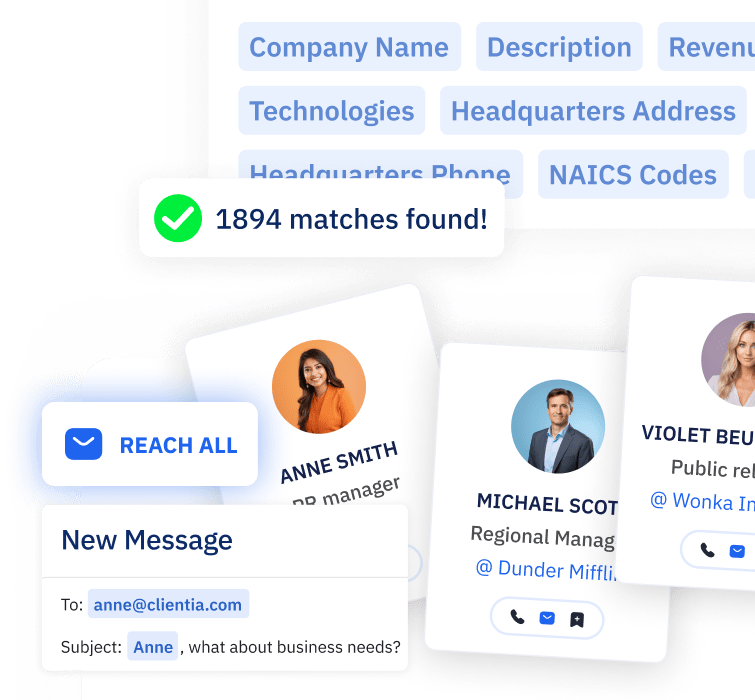In the dynamic world of sales and business development, mastering the terminology is not just about linguistic precision—it’s a strategic imperative. The terms lead, prospect, and opportunity form the triad that underpins the sales process. Understanding these concepts and their distinctions is crucial as each term represents a different stage in the journey from potential market interest to actual revenue generation.
TL;DR
- Leads are potential customers at the start of the sales funnel. They can be qualified or not, depending on how well they match the ideal customer profile.
- Prospects are a step up from leads. They’re leads who are qualified and show substantial interest and engage in sales conversations.
- Opportunities represent prospects with serious buying intent. They’re categorized based on their progression through the sales cycle stages.
- It’s crucial for sales teams to manage these stages effectively, using tools like CRM and marketing automation platforms. Implementing a streamlined sales process is pivotal in enhancing the efficiency of these automation tools, further optimizing the journey from lead to opportunity.
- Processes like lead nurturing and qualification are key to moving leads to prospects, and prospects to opportunities. Sales strategies become more tailored as a lead progresses, with training and data utilization enhancing outcomes.
- Aligning sales and marketing strategies is vital. It ensures coherent messaging, improving lead to sale conversion rates.
- Growbots emphasizes the importance of understanding pain points, refining buyer personas, and data-driven decision-making in revolutionizing sales team operations.
- For more in-depth sales strategies and tactics, Growbots offers resources like CRM systems and lead scoring tools to manage the sales pipeline and boost conversion rates. Try it for free today!
What is a Lead?
A lead is anyone who might buy your product or service. It’s an individual or entity standing at the threshold of your sales funnel, which symbolizes the widest pool of potential customers. But not all leads are created equal; they can be qualified or unqualified, with the former showing characteristics that match your ideal customer profile.
Effective lead generation strategies aim at attracting a high volume of potential customers, which are then filtered to find the best matches for the business.
Types of Leads
Leads come in various forms:
- Online Leads: Acquired through digital channels, including your website, social media, or through email campaigns.
- Referral Leads: Introduced to your business through existing clients or partners.
- Cold Call Leads: Identified through outreach methods like cold emailing or cold calling.
What is a Prospect?
A prospect is a lead that’s been qualified as a good fit for your company’s products or services. Prospects have taken a step further than leads by showing enough interest in what you offer to enter into a conversation with your sales team.
Types of Prospects
Prospects vary in how you engage them:
- Active Prospects: They are actively seeking solutions and are engaged in sales conversations.
- Lukewarm Prospects: They have shown some interest but are not actively seeking solutions.
- Inactive Prospects: These may have gone cold and require re-engagement strategies.
leave no lead unexplored
Every potential client within reach
- 180m+ contacts
- CRM integrations
- 23 Prospect filters
- 15 Company filters
Transitioning from a lead to a prospect involves further qualification. Prospects have been vetted for a higher probability of purchase and an alignment with the company’s target market criteria. The move from leads to prospects signifies a deepening engagement and interest.
Prospecting is crucial, and understanding where to focus your efforts can be gleaned from Growbots’ insights on B2B sales prospecting.
Table: Lead vs. Prospect
| Criteria | Leads | Prospects |
| Interest Level | Initial | Considerable |
| Information | Limited | More Detailed |
| Qualification | Unqualified | Qualified |
What is a Sales Opportunity?
A sales opportunity is a prospect poised on the brink of making a purchase. These individuals or businesses are not just interested in what you have to offer; they’re considering your solution as a serious option.
Identifying and nurturing sales opportunities effectively is key to maximizing the potential for successful deals and growth for any business.
Types of Opportunities
Opportunities are categorized based on their sales cycle stages:
- Early-Stage Opportunities: These are still in the initial phases of the buying process.
- Qualified Opportunities: These have been vetted further and meet all your qualification criteria.
- Close-Winnable Opportunities: Opportunities that are on the verge of closing with a high chance of conversion.
Table: Opportunity Characteristics
| Characteristics | Description |
| Intent | Clear interest in purchasing |
| Engagement | Direct actions taken |
| Priority | High for sales teams |
Sales Funnel
The sales funnel is a model that illustrates the buyer’s journey from awareness to decision-making. Leads, prospects, and opportunities each occupy specific tiers within this funnel. Managing each stage effectively is instrumental in ensuring that the highest number of potential customers convert into actual customers.
For this reason, training sales reps to understand and navigate the funnel effectively is critical for converting these potential customers at each stage.

Significance to Differentiate Leads, Prospects, and Opportunities
Distinguishing between leads, prospects, and opportunities allows for optimized resource allocation and a focused sales strategy. It’s about investing the right amount of time and effort to nudge each category towards the next stage in the sales pipeline.
Comparison Table
| Criteria | Lead | Prospect | Opportunity |
| Interest Level | Initial | Moderate to High | High |
| Qualification | Uncertain | Qualified | High Potential |
| Engagement | Needs Nurturing | More Engaged | Decision-making |
| Sales Readiness | Low | Medium | High |
Lead vs Prospect: What is the Difference?
Crystallizing the difference between a lead and a prospect lies in their engagement and qualification level. Leads encompass a broader spectrum of potential customers. In contrast, prospects are a subset of leads—those who have been qualified based on specific criteria and are considered more likely to make a purchase.
Turning a Lead into a Prospect
Moving a lead to the prospect stage involves a nuanced qualification process. Lead qualification criteria can include metrics such as company size, industry relevance, and identified pain points. Engagement strategies can range from personalized outreach to nurturing through content marketing—anything that builds trust and showcases the value of your product or service.
Prospect vs Opportunity – Transitioning to the Next Stage
Understanding the transition from a prospect to an opportunity is crucial for any sales team. This stage represents a shift from mere interest to a more tangible intent to purchase. Sales teams need to recognize when a prospect has moved beyond general inquiry and has begun to evaluate your product or service seriously.
Identify Signals of Opportunity Readiness
Some signals that indicate a prospect’s transition to an opportunity include:
- A request for detailed product information or pricing
- Inquiries about implementation timelines or service level agreements
- Expression of buying signals or verbal commitments during discussions
Lead Nurturing and The Role of Marketing
Lead nurturing is a collaborative strategy between sales and marketing teams designed to cultivate relationships with potential customers—even if they’re not currently looking to buy. It involves providing information and answers to questions, thus fostering trust and keeping your brand in mind for future purchasing decisions.
The Influence of Content and Marketing Automation
Engaging content, whether it’s a blog post, white paper, or a case study, can effectively maintain a connection with leads. Furthermore, marketing automation can help deliver the right message at the right time, streamlining the nurture journey.
no prior experience & time required
Find your winning outbound formula with Concierge
- 95% activities on our behalf
- Avoid in-house SDR hire
- Learn & Take over anytime
- Numerous A/B tests
Such content and automation tools are invaluable resources for sales reps, as they provide them with tailored material to share with leads and prospects, enhancing engagement and relationship building.
Table: Benefits of Automation
| Automation Benefit | Impact |
| Time Saving | Frees up human hours |
| Consistency | Maintains regular prospect engagement |
| Analysis | Provides data-centered insights |
The Qualification Process
How do you know when a lead becomes a prospect, or when a prospect turns into an opportunity? It all boils down to a systematic qualification process. This includes:
- Assessing if a lead has the budget and authority to buy
- Determining if your offering solves a real problem for the lead
- Ensuring that the lead’s timeline to purchase aligns with your sales cycle
The goal is to identify sales qualified leads (SQLs) and prioritize them for conversion.
Identifying Pain Points and Needs
To successfully navigate leads and prospects through the sales funnel, you must understand their individual pain points. Informed conversations that acknowledge these challenges and position your product as a solution can facilitate progression to the opportunity stage.
Moreover, integrating these insights into your lead generation and campaigns can significantly enhance the relevance and appeal of your efforts to potential customers.
Gathering Insightful Information
Here are a few methods to gather information:
- Direct conversation or discovery calls
- Surveys or feedback forms
- Analysis of engagement data from email and social media interactions
Sales Team Strategies for Converting Opportunities
When a prospect becomes a distinct sales opportunity, the sales team’s approach must be strategic and tailored. Essential tactics include:
- Personalizing communication to address specific needs
- Demonstrating the product’s value and ROI
- Negotiating terms that align with the buyer’s expectations
Continual Engagement and Follow-Up
Persistence and timely follow-up are crucial to maintaining momentum and interest, ultimately leading to a successful sale.
Tools and Technologies in Lead and Prospect Management
Efficient management of leads and prospects often necessitates the use of specialized tools and technologies. A Customer Relationship Management (CRM) system is essential for tracking interactions, while lead scoring helps prioritize efforts. How? Lead scoring systems allow sales teams to quantitatively assess the potential of each lead, ensuring a more targeted and effective approach to sales engagement.
Popular Tools in Sales Funnel Management
- CRM Software: Such as Salesforce, which organizes lead and prospect data, providing insights and recommended actions.
- Marketing Automation Platforms: Like HubSpot, which automate repetitive tasks and personalize customer communication.
Tracking and Measuring Success in the Sales Pipeline
Measuring success in the sales funnel involves tracking key performance indicators (KPIs) through each stage. Metrics might include conversion rates, average sales cycle length, and opportunity win rates.
In-depth analysis of these KPIs helps in fine-tuning strategies to better capture and convert sales opportunities, allowing businesses to focus on the most effective tactics for customer acquisition and retention.
Key Metrics to Track
- Number of leads generated
- Rate at which leads convert to prospects
- Conversion of prospects to opportunities
- Closed deals originating from qualified opportunities

Sales Training and the Importance of Team Knowledge
A well-informed sales team is a more productive one. Ongoing sales training ensures that team members understand the nuances of leads, prospects, and opportunities.
Topics for Training Sessions
- The latest techniques in lead generation and qualification
- Effective communication strategies to convert prospects to opportunities
- Product knowledge for convincing presentations
Aligning Sales and Marketing Efforts
In a symbiotic sales environment, aligning the efforts of both the sales team and the marketing department is critical. By sharing insights and data, teams can collaboratively identify high-quality leads, nurture prospects effectively, and create targeted messages for opportunities that are ready to close.
Integrated Strategies Include:
- Content marketing that directly addresses common questions or concerns of leads at different stages.
- Utilizing MQLs as a benchmark for sales teams to identify high potential SQLs.
- Leveraging data from marketing campaigns to refine sales pitches and approach methods, enhancing personalization.
Refining the Buyer Persona
Understanding the buyer persona is a cornerstone of effective sales processes. By refining the characteristics of the ideal customer, sales and marketing teams can develop more pointed and relevant strategies, specifically tailored to the desires and needs of leads, prospects, and opportunities.
Continuously refining and adapting the sales process based on insights gained from buyer personas ensures that sales tactics remain effective and aligned with customer expectations.
Key Aspects of a Buyer Persona Include:
- Demographics and firmographics
- Behavioral patterns and preferences
- Specific pain points and challenges relevant to the product or service offered
Handling Objections Through the Sales Funnel
Anticipating and handling objections is an integral part of converting leads into prospects and eventually, opportunities into sales. Training sales reps on how to deal with common objections through each stage can increase the chances of advancing the sale.
Some Effective Techniques to Overcome Objections:
- Active listening to fully understand the objections raised
- Clear communication of value propositions that directly address concerns
- Providing evidence or testimonials to assuage doubts and build credibility
Utilizing Data to Enhance Sales Processes
Data-driven decision-making is revolutionizing the way sales teams operate. By utilizing analytics and insights gathered through each stage of the sales funnel, businesses can optimize processes, fine-tune messaging, and forecast sales with greater accuracy.
Morover, incorporating data analytics into customer interactions not only refines sales strategies but also strengthens the business relationship with each customer by ensuring more personalized and relevant communication.
Benefits of Data Utilization Include:
- Improved lead qualification criteria through historical analysis
- More efficient resource allocation based on conversion probability
- Enhanced forecasting models for more predictable sales outcomes
Seek, pick, and reach
Connect with your potential customers
- 180m+ contacts
- Advanced filtering
- Multichannel sequences
- CRM integrations
Conclusion: Achieving Sales Mastery
Understanding and differentiating between leads, prospects, and opportunities is the bedrock of sales mastery. The sales funnel is a non-linear journey that requires nuanced management, tailored strategies, and a seamless alignment between sales and marketing efforts. Success, in this context, translates to a holistically managed funnel that surges with well-defined leads, nurtured prospects, and opportunities ripe for the picking.
Ultimately, the goal of these efforts is to increase the conversion of leads into paying customers, thereby driving business growth and revenue.
Key Takeaways
- Understanding the differences between leads, prospects, and opportunities is crucial for effective sales funnel management.
- Sales and marketing alignment, along with precise buyer personas, are pivotal for converting leads into prospects and prospects into opportunities.
- Data and training empower sales teams to optimize processes, anticipate objections, and enhance conversion rates.
For those aiming to dive deeper into the robust world of sales strategies and expand their repertoire of tactics, exploring the Growbots blog is the next step. With a wealth of resources, from cold email templates to sales prospecting methods, Growbots is a goldmine for anyone looking to refine their sales approach.
FAQ:
Q: How do you transition a lead into a prospect?
A: Transitioning a lead into a prospect involves lead qualification, understanding their needs, and providing relevant solutions that match their profiles. Engagement strategies and personalized communication are vital in moving leads to the prospect status.
Q: What indicates that a prospect has become an opportunity?
A: Key indicators that a prospect has become an opportunity include a clear expression of intent, a willingness to discuss terms or pricing, and engagement with product demos or trials.
Q: Why is alignment between sales and marketing important?
A: Alignment ensures that both teams are working towards a shared goal with coherent messaging and strategies. This synergy can lead to better lead qualification, a smoother customer journey, and higher close rates.
Q: What tools are essential for managing leads, prospects, and opportunities?
A: CRM systems, lead scoring tools, sales engagement platforms, and analytics software are crucial for managing different sales stages. They enable better tracking, prioritization, and interaction with potential customers.
Q: Why is lead qualification important?
A: Lead qualification ensures that efforts are concentrated on leads most likely to convert, improving resource allocation and conversion rates.
Q: How does CRM help in managing the sales pipeline?
A: CRM systems offer a centralized platform for tracking customer interactions and progress within the sales pipeline, enhancing visibility and control over the sales process.






























